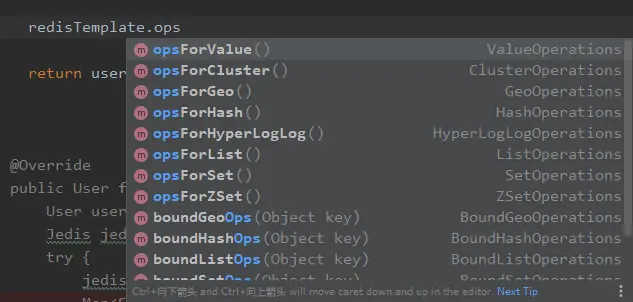您的位置:上海毫米网络优化公司 > 网站优化分享 >
相关推荐recommended
- 网络爬虫之爬虫原理
- IntelliJ IDEA 2023.3 的 AI Assistant
- 什么是栈,如何实现?
- Nginx模块之rewrite模块
- MySQL 之 安装与配置环境变量
- 如何在CentOS安装SQL Server数据库并实现无公网IP远程连
- 【数据结构】双向链表详解
- 解决mysql:2059 -Authentication plugin
- SQLite、MySQL 和 PostgreSQL 数据库速度比较(本
- SpringAI初体验之HelloWorld
- linux的一些基本操作和命令
- 【MySQL】表列数和行大小限制详解
- 如何学习正则表达式
- 5.118 BCC工具之xfsslower.py解读
- MySQL中的SQL高级语句[一](上篇)
- Spring Boot 框架
- go: go.mod file not found in curren
- PHP Swoole Client
- 二刷大数据(一)- Hadoop
- 【微服务】接口幂等性常用解决方案
- 基于springboot的养老院管理系统的设计与实现 (含源码+sql
- 前端vue uni-app仿美团下拉框下拉筛选组件
- error @achrinzanode-ipc@9.2.5: The
- SpringBoot-打印请求的入参和出参
- 输了,腾讯golang一面凉了
- SQL-窗口函数
- SpringBoot使用WebSocket
- SpringBoot接口入参校验的几种方式
- 文生视频大模型Sora的复现经验
- 【论文笔记】Mamba:挑战Transformer地位的新架构
Spring与Redis集成
作者:mmseoamin日期:2024-02-04
1.引入RedisTemplate
据以前的情况,我们在Java中使用Redis时一般是使用Jedis来操作的,大致的一段代码如下所示
@Override
public User findUserById(Integer id) {
User user = null;
Jedis jedis = null;
try {
jedis = jedisPool.getResource();
String userStr = jedis.get("user_" + id); // 尝试获取数据
if (userStr != null && !userStr.isEmpty()) { // 如果获取到有效数据,则转换后返回
user = JSONObject.parseObject(userStr, User.class);
} else {// 如果没有获取到数据,则查询数据库返回
user = userMapper.findUserById(id);
if (user != null) jedis.set("user_" + id, JSONObject.toJSONString(user)); // 设置到redis中
}
} finally {
// 记得关闭Jedis,因为这里使用的是JedisPool,所以这里的关闭并不是直接关闭连接,而是释放,以供其他的业务使用
if (jedis != null) jedis.close();
}
return user;
}
上边的这样的一段代码其实是有些臃肿的,但是如果我们引入RedisTemplate,其实会简化不少。
- maven 引入 spring-data-redis
redis.clients jedis3.9.0 org.springframework.data spring-data-redis2.2.13.RELEASE - 将RedisTemplate 加入Bean容器中,让Spring进行管理。
@Bean public RedisConnectionFactory redisConnectionFactory() { RedisStandaloneConfiguration redisStandaloneConfiguration = new RedisStandaloneConfiguration(); redisStandaloneConfiguration.setHostName(host); redisStandaloneConfiguration.setPort(port); RedisConnectionFactory redisConnectionFactory = new JedisConnectionFactory(redisStandaloneConfiguration); return redisConnectionFactory; } @Bean public RedisTemplate redisTemplate(RedisConnectionFactory redisConnectionFactory) { RedisTemplate redisTemplate = new RedisTemplate(); redisTemplate.setConnectionFactory(redisConnectionFactory); //设置key值的序列化方式,默认是JDK的形式 redisTemplate.setKeySerializer(StringRedisSerializer.UTF_8); return redisTemplate; }- 如果使用RedisTemplate的替换的话,会简洁很多。
@Autowired private RedisTemplate redisTemplate; @Override public User findUserById(Integer id) { Object result = redisTemplate.opsForValue().get("user_" + id); if (result != null) return (User) result; User user = userMapper.findUserById(id); // 设置到redis中 if (user != null) redisTemplate.opsForValue().set("user_" + id, user); return user; }- 大概看一下关于RedisTemplate的方法

看了以上的内容,可以看到引入了RedisTemplate其实已经很简洁了,但是明显还不够,下面我们将考虑引入 “注解”
2. 引入注解
- 开启缓存 @EnableCaching
@Configuration @EnableCaching public class AppConfig { ... }- 引入@Cacheable,表示这个方法将会访问缓存,如果无法命中缓存的话,会将方法返回的值存入redis,假设有注解为 @Cacheable(value="user", key = "#id"),那么生成的key值为 user::{id},即如果id为1 那么生成的 key就是 user::1
@Override @Cacheable(value="user", key = "#id") // 这里返回的值会被存放到redis,key-value格式,其中生成的key值(假设id为1): user::1 public User findUserById(Integer id) { User user = userMapper.findUserById(id); return user; }但是这样还不够,因为Spring并不清楚缓存的方式是什么,这就涉及到CacheManager 了
- 设置CacheManager,在AppConfig中加入以下内容
@Bean public RedisConnectionFactory redisConnectionFactory() { RedisStandaloneConfiguration redisStandaloneConfiguration = new RedisStandaloneConfiguration(); redisStandaloneConfiguration.setHostName(host); // 这里是redis的ip redisStandaloneConfiguration.setPort(port);// 这里是redis的端口 // 自适应集群变化 RedisConnectionFactory redisConnectionFactory = new JedisConnectionFactory(redisStandaloneConfiguration); return redisConnectionFactory; } @Bean public RedisCacheConfiguration redisCacheConfiguration() { RedisCacheConfiguration redisCacheConfiguration = RedisCacheConfiguration.defaultCacheConfig() .serializeKeysWith(RedisSerializationContext.SerializationPair.fromSerializer(RedisSerializer.string())) .serializeValuesWith(RedisSerializationContext.SerializationPair.fromSerializer(RedisSerializer.json())); return redisCacheConfiguration; } @Bean public RedisCacheWriter redisCacheWriter(RedisConnectionFactory redisConnectionFactory) { RedisCacheWriter redisCacheWriter = RedisCacheWriter.nonLockingRedisCacheWriter(redisConnectionFactory); return redisCacheWriter; } @Bean public CacheManager cacheManager(RedisCacheWriter redisCacheWriter, RedisCacheConfiguration redisCacheConfiguration) { CacheManager cacheManager = new RedisCacheManager(redisCacheWriter, redisCacheConfiguration); ((RedisCacheManager) cacheManager).isTransactionAware(); return cacheManager; }
3. 自行通过注解和AOP实现缓存
- 引入AOP相关的包
org.springframework spring-aop 5.3.22 org.springframework spring-aspects 5.3.22 com.fasterxml.jackson.core jackson-core 2.9.8 com.fasterxml.jackson.core jackson-databind 2.9.8 com.fasterxml.jackson.core jackson-annotations 2.9.8 com.alibaba fastjson 1.2.28 - 创建@CustomCache
@Target(ElementType.METHOD) @Retention(RetentionPolicy.RUNTIME) public @interface CustomCache { /** * key的规则,可以使用springEL表达式,可以使用方法执行的一些参数 */ String key(); /** * 类似前缀 * @return */ String value(); }- 修改AppConfig
@EnableAspectJAutoProxy // 开启AOP自动代理 public class AppConfig { @Bean public RedisConnectionFactory redisConnectionFactory() { RedisStandaloneConfiguration redisStandaloneConfiguration = new RedisStandaloneConfiguration(); redisStandaloneConfiguration.setHostName(host); redisStandaloneConfiguration.setPort(port); // 自适应集群变化 RedisConnectionFactory redisConnectionFactory = new JedisConnectionFactory(redisStandaloneConfiguration); return redisConnectionFactory; } @Bean public RedisTemplate redisTemplate(RedisConnectionFactory redisConnectionFactory) { RedisTemplate redisTemplate = new RedisTemplate(); redisTemplate.setConnectionFactory(redisConnectionFactory); redisTemplate.setKeySerializer(StringRedisSerializer.UTF_8); redisTemplate.setValueSerializer(StringRedisSerializer.UTF_8); return redisTemplate; } }- 创建 CustomCacheAspect
@Component @Aspect public class CustomCacheAspect { @Autowired private RedisTemplate redisTemplate; @Pointcut("@annotation(cn.lazyfennec.cache.redis.annotation.CustomCache)") public void cachePointcut() { } @Around("cachePointcut()") public Object doCache(ProceedingJoinPoint joinPoint) { Object obj = null; try { MethodSignature signature = (MethodSignature) joinPoint.getSignature(); Method method = joinPoint.getTarget().getClass().getMethod(signature.getName(), signature.getMethod().getParameterTypes()); CustomCache customCache = method.getAnnotation(CustomCache.class); String cacheKey = customCache.key(); String cacheValue = customCache.value(); // 创建解析器 ExpressionParser parser = new SpelExpressionParser(); Expression expression = parser.parseExpression(cacheKey); EvaluationContext context = new StandardEvaluationContext(); // 参数 // 添加参数 Object[] args = joinPoint.getArgs(); DefaultParameterNameDiscoverer discover = new DefaultParameterNameDiscoverer(); String[] parameterNames = discover.getParameterNames(method); for (int i = 0; i < parameterNames.length; i++) { context.setVariable(parameterNames[i], args[i].toString()); } // 解析 String key = cacheValue + "::" + expression.getValue(context).toString(); // 1、 判定缓存中是否存在 obj = redisTemplate.opsForValue().get(key); if (obj != null) return obj; // 2、不存在则继续行方法 obj = joinPoint.proceed(); // 3、 同步存储value到缓存。 redisTemplate.opsForValue().set(key, obj); } catch (NoSuchMethodException e) { e.printStackTrace(); } catch (Throwable throwable) { throwable.printStackTrace(); } return obj; } }- 新建方法 getUserNameById
@RequestMapping("/custom/name/{id}") @ResponseBody public String getUserNameById(@PathVariable Integer id) { return userService.getUserNameById(id); }- 实际实现方法 getUserNameById,使用方式
@Override @CustomCache(value = "custom_user", key = "#id") public String getUserNameById(Integer id) { return userMapper.findUserNameById(id); }
- 实际实现方法 getUserNameById,使用方式
- 新建方法 getUserNameById
- 创建 CustomCacheAspect
- 修改AppConfig
- 创建@CustomCache
- 引入AOP相关的包
- 设置CacheManager,在AppConfig中加入以下内容
- 引入@Cacheable,表示这个方法将会访问缓存,如果无法命中缓存的话,会将方法返回的值存入redis,假设有注解为 @Cacheable(value="user", key = "#id"),那么生成的key值为 user::{id},即如果id为1 那么生成的 key就是 user::1
- 开启缓存 @EnableCaching
- 大概看一下关于RedisTemplate的方法
- 如果使用RedisTemplate的替换的话,会简洁很多。
- 将RedisTemplate 加入Bean容器中,让Spring进行管理。














